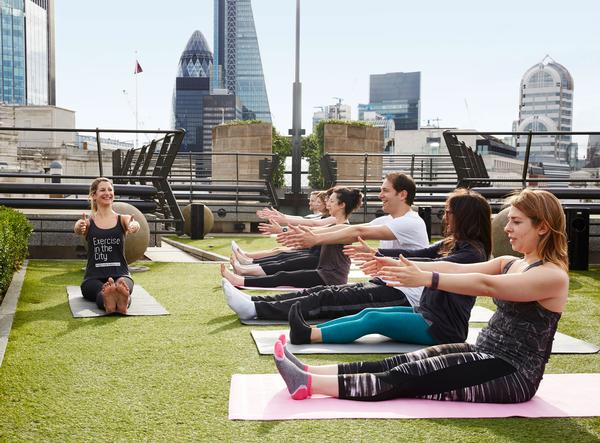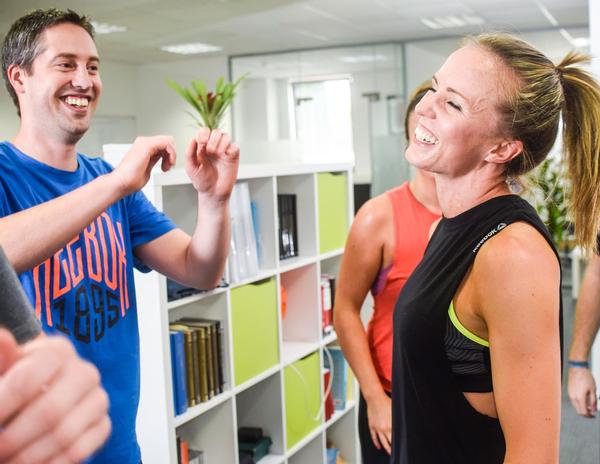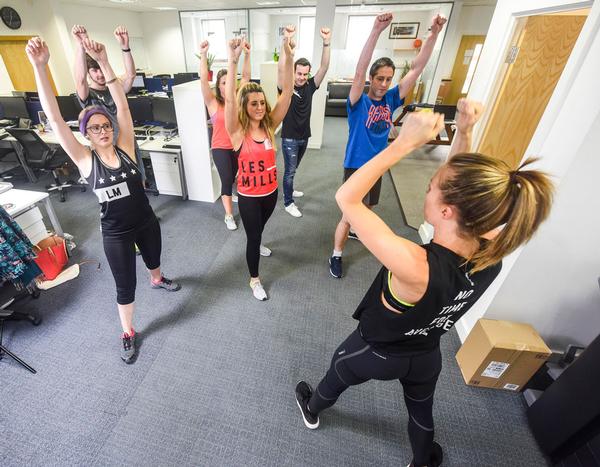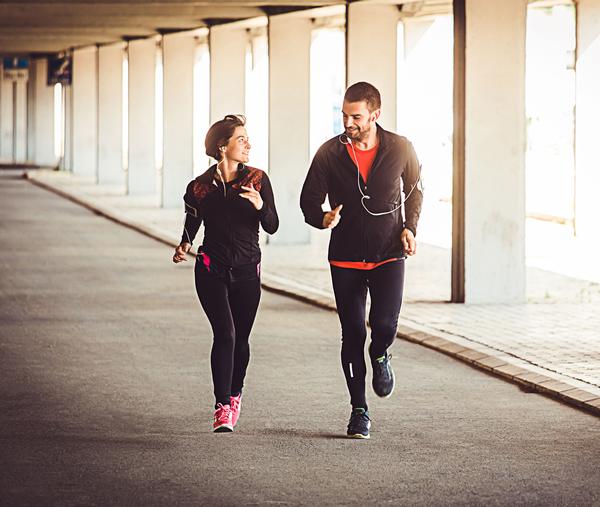



SELECTED
ISSUE
|
|
Leisure Management - Active @ work

Talking point

|
|
| Active @ work
|

Sitting is the new smoking, say health experts, with office workers’ sedentary hours stuck at a desk a particular worry. So what can we do about this? Kath Hudson reports
|


Exercise in the City now works with 30 organisations across London

At Les Mills UK, both staff and visitors are encouraged to take part in exercise classes during the working day

At Les Mills UK, both staff and visitors are encouraged to take part in exercise classes during the working day

Will ‘meetings-on-the-go’ be the norm in workplaces of the future? PHOTO: SHUTTERSTOCK.COM
|
|
|
Office workers have been given something new to worry about. According to a major study published in The Lancet recently, sitting for eight hours a day can increase the risk of premature death by up to 60 per cent. In fact, it’s likely to be the cause of more deaths than obesity. The study’s lead scientist, professor Ulf Ekelund of Cambridge University, is urging all desk workers to stand up and take a five-minute break every hour, and to support this with one hour of brisk walking or cycling every day. Ideally activity should be spread throughout the day. Leading by example
Some of the world’s most progressive companies are already taking steps to counter workplace inactivity. Red Bull has slides and ping pong tables in meeting rooms, Google has a gym and a 90m indoor running track and Microsoft has treadmill desks. But is that enough? Health experts argue that a new mindset is needed: networking while working out, for example – dubbed ‘sweatworking’ – and meetings that involve all participants standing or even walking. A few companies are already doing this, especially in the US. Chicago-based company aSweatLife.com hosts monthly networking events called #Sweatworking, where networking and exercise come together. Meanwhile 321Launch has partnered with health and fitness operators like Barry’s Bootcamp and SoulCycle for business meetings. At Les Mills UK, staff have the option of taking part in classes run throughout the day in its studio, or doing a Les Mills On-Demand virtual session at any time. All visitors are invited to take part too. “The biggest battle for activity is within the industry,” says Martin Franklin, CEO of Les Mills UK. “If the people working in the fitness sector don’t get the value of activity for personal wellbeing, how can we ever hope to impact the lives of the rest of the population? We don’t insist they do a workout here with us, but if they don’t, we ask them – in an honour system – to work out in the next 24 hours.” So will momentum gather in favour of more active offices? We ask the experts.
|
|
 |

Julia Scodie
Founder
Exercise in the City
 |
|
Five years ago I was a sedentary office-worker, with a busy desk job as a project manager for a charity. I wasn’t inclined to exercise, partly because I didn’t like the idea of going to a gym, and often because I didn’t have the time or motivation to exercise after a day at the office. I also have scoliosis, which causes muscle tightness, so I didn’t have much flexibility – another excuse I made not to exercise!
Then a pilates instructor started coming into my office once a week. After a few sessions I started to see and feel a big difference in my body and I fell in love with pilates. In 2011, I decided to retrain as an instructor – I’m now the person going into offices, persuading people like I used to be to exercise.
A lot of our clients are new to physical activity and frequently ask about other classes once they get started with our sessions.
I now work with about 30 organisations in London, including charities, corporate offices and the public sector. Companies mostly want an instructor at lunchtime or after work, so I work with a team of other freelance instructors to meet the demand.
Pilates and yoga are the most popular options, as people don’t have to worry about getting hot and sweaty or knocking things over! If companies want Zumba or other more energetic classes, these require designated space and tend to be after work, unless the company offers showers.
In my experience, it’s important to find a champion within the company to make it work. It can be difficult to find the right person to talk to, as this isn’t a role that’s represented in most organisations.
My success with Exercise in the City has come from finding the right contact who really wants it to work and who will drive people to attend the sessions.
"It’s important to find a champion within the company – someone who really wants it to work and who will drive people to attend the sessions" – Julia Scodie
|
|
 |

Steven Ward
Executive Director
ukactive
 |
|
Sedentary habits at work are harming the health of millions of employees in the UK every day, and as the research shows, the consequences of ignoring this will be deadly. We cracked down on smoking very effectively and now we need to turn that firepower onto inactive offices.
Academic studies show the return on investment for companies that invest in staff wellbeing programmes is around £3 for every £1 spent, so it’s also a no-brainer from a business perspective.
The key for gym operators is building relationships with nearby businesses, so they become aware of your services and the role you can play in safeguarding their workforce from sedentary office life. Becoming a second home for the growing number of flexible and home-based workers is another major opportunity.
While the long-term goal might be signing up firms for regular sweatworking sessions and corporate gym memberships, there are many easy ice-breakers that can begin these conversations. For example, visit employers to run office-based workshops on staying active, or simply create five-minute activity programmes aimed at workers that can be shared via social media or email with the office you’re visiting.
Motivational interviewing programmes – like Let’s Get Moving, developed by ukactive – also have a crucial role to play in engaging inactive employees who are initially hard to engage.
Once we start to have genuinely helpful conversations and get offices moving, we can expect to see progress towards more substantial work-based activity offerings.
In terms of absenteeism, productivity, health and happiness, our offices are in dire need of activity initiatives. It’s time for our sector to step up and seize the opportunity.
"The ROI for companies that invest in staff wellbeing programmes is around £3 for every £1 spent, so it’s a no-brainer" – Steve Ward
|
|
 |

Paul Kienstra
CEO
High Five Health Promotion
 |
|
Sweatworking brings together three different elements: being active, while networking, to make the brain work more effectively. Most companies are a very long way from this at the moment, and to bring about the necessary shift will require a lot of thinking outside the box.
One major challenge is that the concept flies in the face of a number of Western world habits. We have a sitting-down culture, needing to network with alcohol and seal business deals over dinner. To change this requires a mindset shift – and this needs to start with the health and fitness industry itself.
Last week I was at the EuropeActive forum and listened to a lot of talks about health and fitness. Apart from myself and two others, everyone sat down for the duration of the talks. If the health and fitness industry won’t stand up, how can we expect other industries to do so?
We have to lead on this, and there are a number of opportunities. Health and fitness clubs located in, or near, a business area could run networking events, replacing alcohol with exercise. If these are run during business hours, it could be a good use of club facilities during quieter hours.
Operators could also go to companies and offer to organise active breaks or meetings. In this case it’s important to start with a low bar, encouraging people to stand for some of the meeting. The room needs to be organised in such a way that it’s easy for people to make the choice between sitting and standing. If exercise is incorporated, the intensity must be moderate.
But there is an opportunity here, so let’s lead the way and make it happen.
"Operators could go to companies and offer to organise active breaks or meetings, encouraging people to stand for some of the meeting" – Paul Kienstra
|
|
 |

Danny Oliver
UK Country Manager
Life Fitness
 |
|
When I went through the selection process at Life Fitness, I was warned by my interviewers that they might get up and walk around. To start with this was disconcerting, but now I’ve acclimatised to the culture and regularly stand throughout my working day, whether at my desk or with colleagues and customers. Sometimes customers ask me about it when they visit our offices, but it’s just become standard in my daily work routine.
Life Fitness is ahead of the curve with its approach to an active office: if there are 15 of us in a meeting, we’ll all sit and stand at different times. Very often we’ll have our smaller meetings walking on the 1.5-mile trim trail outside the office. In addition, the company is divided into four teams and every quarter we have fitness challenges, such as racing around the trail or a tug of war.
While I accept that it’s a fairly easy sell to get our employees to embrace the idea of sweatworking and an active office – they do, after all, work in fitness – I absolutely believe this concept will gain traction and fast become mainstream.
We’re currently talking to all sorts of companies – from large corporates to local authorities and the Ministry of Defence – about our InMovement adjustable height desks and desks that incorporate a treadmill, allowing people to be active while working.
"At Life Fitness, if there are 15 of us in a meeting, we’ll all sit and stand at different times. Very often we’ll have our smaller meetings walking on the 1.5-mile trim trail outside the office" – Danny Oliver
|
|
 |
| Originally published in Health Club Management 2016 issue 11
|
|
 |
|
